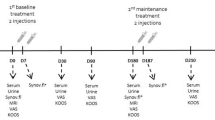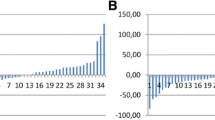Abstract
Intra-articular hyaluronic acid has been used in treatment of patients with knee osteoarthritis. Though its effect on pain has been well studied, it is not clear how it affects the articular cartilage. This is a preliminary study to evaluate the kinetics of urinary collagen type-II C-telopeptide (CTX-II) as a biomarker of collagen breakdown in response to intra-articular hyaluronic acid injection in patients with symptomatic knee osteoarthritis. Intra-articular injections of hyaluronan were administered to ten patients with symptomatic knee osteoarthritis. Urine collection for urinary CTX-II was obtained at baseline, before each injection and once every other week for a total of 6 months. Urine CTX-II was measured using a CartiLaps© ELISA kit. There was a statistically significant increase (p = 0.0136) in CTX-II a week after the third intra-articular injection of hyaluronic acid (6,216 ng/mmol ± 4,428) compared with baseline (2,233 ng/mmol ± 1,220). This increase in CTX-II was sustained throughout the entire 6 months follow-up period (repeated measures ANOVA, p < 0.015). This is the first study of changes in an osteoarthritis biomarker after intra-articular hyaluronic acid injections in patients with symptomatic knee osteoarthritis. Contrary to our initial hypothesis that CTX-II levels should decrease after intra-articular hyaluronic acid injections, we found a significant increase in urinary CTX-II levels that was sustained throughout the study. These observations suggest that intra-articular hyaluronic acid injections may accelerate cartilage breakdown in patients with symptomatic knee osteoarthritis. The responsible mechanisms are unknown and warrant further study.

Similar content being viewed by others
Abbreviations
- CTX-II:
-
Collagen type-II C-telopeptide
- OA:
-
Osteoarthritis
- HA:
-
Hyaluronic acid
- RA:
-
Rheumatoid arthritis
- HMW:
-
High molecular weight
References
Felson DT, Naimark A, Anderson J, Kazis L, Castelli W, Meenan RF (1987) The prevalence of knee osteoarthritis in the elderly. The Framingham Osteoarthritis Study. Arthritis Rheum 30(8):914–918
National Center for Chronic Disease Prevention and Health Promotion (2008) http://www.cdc.gov/arthritis/arthritis/osteoarthritis.htm. Last revised: January 11
Supartz package insert. In: Smith and Nephew, Memphis; Revised: January 30 2007
Brzusek D, Petron D (2008) Treating knee osteoarthritis with intra-articular hyaluronans. Curr Med Res Opin 24(12):3307–3322
Caborn D, Rush J, Lanzer W, Parenti D, Murray C (2004) A randomized, single-blind comparison of the efficacy and tolerability of hylan G-F 20 and triamcinolone hexacetonide in patients with osteoarthritis of the knee. J Rheumatol 31(2):333–343
Lisignoli G, Grassi F, Zini N, Toneguzzi S, Piacentini A, Guidolin D et al (2001) Anti-Fas-induced apoptosis in chondrocytes reduced by hyaluronan: evidence for CD44 and CD54 (intercellular adhesion molecule 1) invovement. Arthritis Rheum 44(8):1800–1807
Christgau S, Garnero P, Fledelius C, Moniz C, Ensig M, Gineyts E et al (2001) Collagen type II C-telopeptide fragments as an index of cartilage degradation. Bone 29(3):209–215
Garnero P, Ayral X, Rousseau JC, Christgau S, Sandell LJ, Dougados M et al (2002) Uncoupling of type II collagen synthesis and degradation predicts progression of joint damage in patients with knee osteoarthritis. Arthritis Rheum 46(10):2613–2624
Garnero P, Conrozier T, Christgau S, Mathieu P, Delmas PD, Vignon E (2003) Urinary type II collagen C-telopeptide levels are increased in patients with rapidly destructive hip osteoarthritis. Ann Rheum Dis 62(10):939–943
Reijman M, Hazes JM, Bierma-Zeinstra SM, Koes BW, Christgau S, Christiansen C et al (2004) A new marker for osteoarthritis: cross-sectional and longitudinal approach. Arthritis Rheum 50(8):2471–2478
Jordan KM, Syddall HE, Garnero P, Gineyts E, Dennison EM, Sayer AA et al (2006) Urinary CTX-II and glucosyl-galactosyl-pyridinoline are associated with the presence and severity of radiographic knee osteoarthritis in men. Ann Rheum Dis 65(7):871–877
Meulenbelt I, Kloppenburg M, Kroon HM, Houwing-Duistermaat JJ, Garnero P (2006) Hellio Le Graverand MP, et al. Urinary CTX-II levels are associated with radiographic subtypes of osteoarthritis in hip, knee, hand, and facet joints in subject with familial osteoarthritis at multiple sites: the GARP study. Ann Rheum Dis 65(3):360–365
Bruyere O, Collette J, Kothari M, Zaim S, White D, Genant H et al (2006) Osteoarthritis, magnetic resonance imaging, and biochemical markers: a one year prospective study. Ann Rheum Dis 65(8):1050–1054
Garnero P, Peterfy C, Zaim S, Schoenharting M (2005) Bone marrow abnormalities on magnetic resonance imaging are associated with type II collagen degradation in knee osteoarthritis: a three-month longitudinal study. Arthritis Rheum 52(9):2822–2829
Bedson J, Croft PR (2008) The discordance between clinical and radiographic knee osteoarthritis: a systematic search and summary of the literature. BMC Musculoskelet Disord 9:116
Zhai G, Cicuttini F, Ding C, Scott F, Garnero P, Jones G (2007) Correlates of knee pain in younger subjects. Clin Rheumatol 26(1):75–80
Gineyts E, Mo JA, Ko A, Henriksen DB, Curtis SP, Gertz BJ et al (2004) Effects of ibuprofen on molecular markers of cartilage and synovium turnover in patients with knee osteoarthritis. Ann Rheum Dis 63(7):857–861
Kong SY, Stabler TV, Criscione LG, Elliott AL, Jordan JM, Kraus VB (2006) Diurnal variation of serum and urine biomarkers in patients with radiographic knee osteoarthritis. Arthritis Rheum 54(8):2496–2504
Qvist P, Munk M, Hoyle N, Christiansen C (2004) Serum and plasma fragments of C-telopeptides of type I collagen (CTX) are stable during storage at low temperatures for 3 years. Clin Chim Acta 350(1–2):167–173
Pozo MA, Balazs EA, Belmonte C (1997) Reduction of sensory responses to passive movements of inflamed knee joints by hylan, a hyaluronan derivative. Exp Brain Res 116(1):3–9
Gomis A, Miralles A, Schmidt RF, Belmonte C (2007) Nociceptive nerve activity in an experimental model of knee joint osteoarthritis of the guinea pig: effect of intra-articular hyaluronan application. Pain 130(1–2):126–136
Gomis A, Miralles A, Schmidt RF, Belmonte C (2009) Intra-articular injections of hyaluronan solutions of different elastoviscosity reduce nociceptive nerve activity in a model of osteoarthritic knee joint of the guinea pig. Osteoarthritis Cartilage 17(6):798–804
Knudson W, Casey B, Nishida Y, Eger W, Kuettner KE, Knudson CB (2000) Hyaluronan oligosaccharides perturb cartilage matrix homeostasis and induce chondrocytic chondrolysis. Arthritis Rheum 43(5):1165–1174
Termeer CC, Hennies J, Voith U, Ahrens T, Weiss JM, Prehm P et al (2000) Oligosaccharides of hyaluronan are potent activators of dendritic cells. J Immunol 165(4):1863–1870
Fernandes JC, Martel-Pelletier J, Pelletier JP (2002) The role of cytokines in osteoarthritis pathophysiology. Biorheology 39(1–2):237–246
Lohmander LS, Atley LM, Pietka TA, Eyre DR (2003) The release of crosslinked peptides from type II collagen into human synovial fluid is increased soon after joint injury and in osteoarthritis. Arthritis Rheum 48(11):3130–3139
Nielsen RH, Stoop R, Leeming DJ, Stolina M, Qvist P, Christiansen C et al (2008) Evaluation of cartilage damage by measuring collagen degradation products in joint extracts in a traumatic model of osteoarthritis. Biomarkers 13(1):79–87
Kim HJ, Lee YH, Kim CK (2009) Changes in serum cartilage oligomeric matrix protein (COMP), plasma CPK and plasma hs-CRP in relation to running distance in a marathon (42.195 km) and an ultra-marathon (200 km) race. Eur J Appl Physiol 105(5):765–770
Garnero P, Piperno M, Gineyts E, Christgau S, Delmas PD, Vignon E (2001) Cross sectional evaluation of biochemical markers of bone, cartilage, and synovial tissue metabolism in patients with knee osteoarthritis: relations with disease activity and joint damage. Ann Rheum Dis 60(6):619–626
Depuy Website: http://www.orthoviscline.com/replace-what-missing/safety
Bagger YZ, Tanko LB, Alexandersen P, Karsdal MA, Olson M, Mindeholm L et al (2005) Oral salmon calcitonin induced suppression of urinary collagen type II degradation in postmenopausal women: a new potential treatment of osteoarthritis. Bone 37(3):425–430
Manicourt DH, Azria M, Mindeholm L, Thonar EJ, Devogelaer JP (2006) Oral salmon calcitonin reduces Lequesne’s algofunctional index scores and decreases urinary and serum levels of biomarkers of joint metabolism in knee osteoarthritis. Arthritis Rheum 54(10):3205–3211
Manicourt DH, Bevilacqua M, Righini V, Famaey JP, Devogelaer JP (2005) Comparative effect of nimesulide and ibuprofen on the urinary levels of collagen type II C-telopeptide degradation products and on the serum levels of hyaluronan and matrix metalloproteinases-3 and -13 in patients with flare-up of osteoarthritis. Drugs R D 6(5):261–271
Lehmann HJ, Mouritzen U, Christgau S, Cloos PA, Christiansen C (2002) Effect of bisphosphonates on cartilage turnover assessed with a newly developed assay for collagen type II degradation products. Ann Rheum Dis 61(6):530–533
Acknowledgements
Reetakshi Arora, PhD
John I. Thornby, PhD
Conflicts of interest statement
None of the authors involve have any financial and personal relationships with other people or organizations that could inappropriately influence the study.
Author information
Authors and Affiliations
Corresponding author
Rights and permissions
About this article
Cite this article
Gonzalez-Fuentes, A.M., Green, D.M., Rossen, R.D. et al. Intra-articular hyaluronic acid increases cartilage breakdown biomarker in patients with knee osteoarthritis. Clin Rheumatol 29, 619–624 (2010). https://doi.org/10.1007/s10067-010-1376-8
Received:
Accepted:
Published:
Issue Date:
DOI: https://doi.org/10.1007/s10067-010-1376-8




